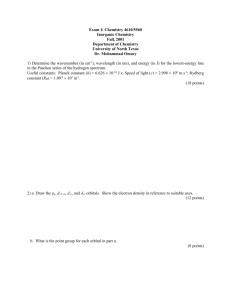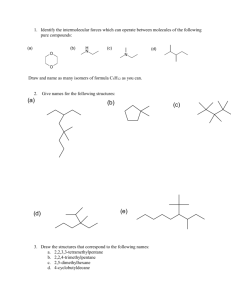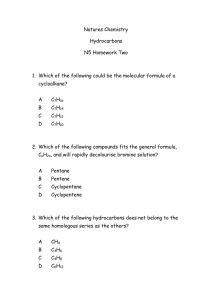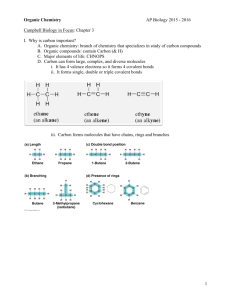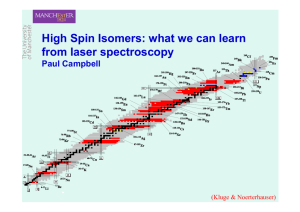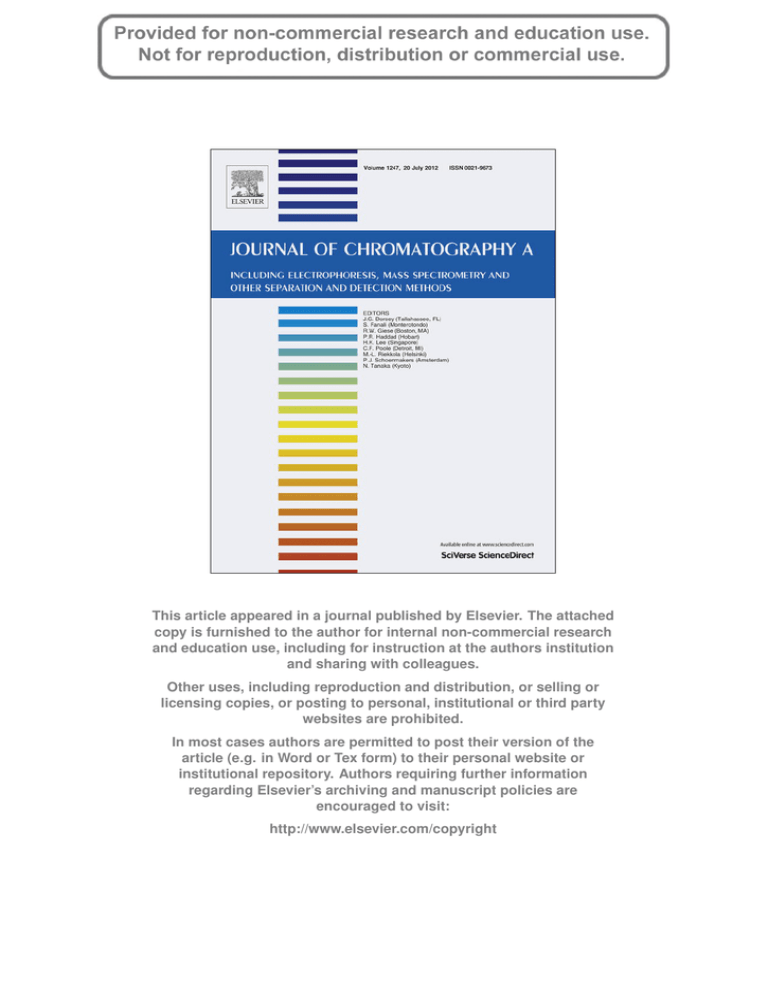
This article appeared in a journal published by Elsevier. The attached
copy is furnished to the author for internal non-commercial research
and education use, including for instruction at the authors institution
and sharing with colleagues.
Other uses, including reproduction and distribution, or selling or
licensing copies, or posting to personal, institutional or third party
websites are prohibited.
In most cases authors are permitted to post their version of the
article (e.g. in Word or Tex form) to their personal website or
institutional repository. Authors requiring further information
regarding Elsevier’s archiving and manuscript policies are
encouraged to visit:
http://www.elsevier.com/copyright
Author's personal copy
Journal of Chromatography A, 1247 (2012) 165–170
Contents lists available at SciVerse ScienceDirect
Journal of Chromatography A
journal homepage: www.elsevier.com/locate/chroma
Short communication
Rapid characterization of perfluoralkyl carboxylate, sulfonate, and sulfonamide
isomers by high-performance liquid chromatography–tandem mass
spectrometry
Jonathan P. Benskin a,b,∗ , Michael G. Ikonomou b , Million B. Woudneh a , John R. Cosgrove a
a
b
AXYS Analytical Services Ltd., Sidney BC, Canada V8L5X2
Institute of Ocean Sciences, Fisheries and Oceans Canada (DFO), 9860 West Saanich Road, Sidney BC, Canada V8L4B2
a r t i c l e
i n f o
Article history:
Received 21 March 2012
Received in revised form 30 April 2012
Accepted 23 May 2012
Available online 29 May 2012
Keywords:
Perfluorinated acids
Isomers
LC–MS/MS
Fused core
Pentafluorophenylpropyl
a b s t r a c t
A rapid (<23 min) new HPLC–MS/MS method was developed for simultaneous characterization of 24 perand polyfluoroalkyl compounds in landfill leachate. In addition to isomer-specific analysis of perfluorooctane sulfonate and perfluorooctanoate, branched from linear isomer separation was accomplished for C6
and C10 perfluoroalkyl sulfonates, C6, C7 and C9–C11 perfluoroalkyl carboxylates, perfluorooctane sulfonamide and, for the first time, 3 perfluorooctane sulfonamidoacetates. The method utilizes a fused-core
pentafluorophenylpropyl (PFP) stationary phase and is approximately 4 times faster than previous comprehensive isomer-specific HPLC–MS/MS methods. This is the first isomer-specific methodology which
can be adopted for routine analysis without sacrificing throughput from lengthy run times or limited
target lists.
© 2012 Elsevier B.V. All rights reserved.
1. Introduction
Per- and poly fluorinated compounds (collectively ‘PFCs’)
encompass a diverse class of substances manufactured for over 60
years for numerous commercial processes and consumer products.
Perfluorooctane sulfonate (PFOS) and perfluorooctanoate (PFOA)
are among the PFCs garnering international attention due to their
widespread global distribution [1], persistence in humans [2] and
links to adverse health outcomes in lab animals and humans [3].
Most PFCs have been commercially manufactured as isomeric
mixtures by electrochemical fluorination (ECF) and/or as single
(typically linear) isomers by telomerization (reviewed elsewhere
[4]). Several studies have highlighted the application of isomerspecific analysis for manufacturing [5] and exposure [6] source
elucidation, and for potential improvements in analytical accuracy [7,8]. The importance of isomer-specific analysis is further
exemplified by evidence of isomer-specific toxicity [9] and pharmacokinetics [10], along with highly variable PFOS isomer profiles
in humans [7,11,12] and wildlife [13,14].
Despite the potential utility of isomer-specific methodologies, few are currently available. Isomer-specific gas
chromatography–mass spectrometry (GC–MS) methods are
∗ Corresponding author at: AXYS Analytical Services Ltd., 2045 Mills Road West,
Sidney BC, Canada V8L5X2. Tel.: +1 250 655 5800; fax: +1 250 655 5811.
E-mail address: jbenskin@axys.com (J.P. Benskin).
0021-9673/$ – see front matter © 2012 Elsevier B.V. All rights reserved.
http://dx.doi.org/10.1016/j.chroma.2012.05.077
limited to perfluoroalkyl carboxylates (PFCAs), [15] sulfonates
(PFSAs), [16] or certain perfluorooctane sulfonamides (FOSAMs),
[4] but not all three classes simultaneously (Table 1). Liquid
chromatography–tandem mass spectrometry (LC–MS/MS)-based
methods are more common, but these tend to suffer from lengthy
run times (95–115 min; Table 1), or are limited to single compounds
(typically PFOS; Table 1). Ultra performance liquid chromatography (UPLC) has also shown promise for isomer-specific analysis of
PFOS and PFOA [17,18], but the additional costs associated with
these systems may be prohibitive for some labs.
The lack of characterized isomeric mixtures (currently only
available for PFOS and PFOA) has hampered development of new
isomer separation methods. While a few PFCs (e.g. perfluorohexane
sulfonate (PFHxS) or perfluorooctane sulfonamide (FOSA)) can be
obtained as uncharacterized technical isomer mixtures, others (e.g.
perfluorooctane sulfonamido acetate; FOSAA) are only available as
the linear isomer.
The objective of the present work was to develop a rapid,
isomer-specific methodology for PFOS and PFOA which also facilitates “total branched” from linear isomer separation for other PFC
targets, including PFCs for which branched isomers have not been
previously reported. A fused-core, pentafluorophenylpropyl (PFP)
stationary phase was tested based on prior success in resolving
PFC isomers using fluorinated stationary phases [19,20]. Technical standards (containing branched and linear isomers) of PFHxS,
FOSA, PFOS, and PFOA were utilized for initial method development. To assess the method’s potential for chromatographically
Author's personal copy
23 min
resolving PFC isomers in real samples, and to examine resolution of
PFC isomers for which branched isomer standards are not commercially available, we applied the method to landfill leachate samples.
PFC isomer profiles in landfill leachate have not previously been
examined; however elevated concentrations of ECF-manufactured
PFCs have been reported consistently in leachates from Europe and
North America, [21,22] increasing the likelihood of branched isomer detection.
PFBS, PFHxS, PFDS, PFDA,
FOSA, FOSAA, NMeFOSAA,
NEtFOSAA, PFBA, PFPA,
PFHxA, PFHpA, PFNA, PFDA,
PFUnA, PFDoA, PFTA,
fluotelomer acids
∼23 min
5–8
6–10
HPLC–MS/MS
Present study
Fused core
pentafluorophenyl propyl
6
8
C18
UPLC–MS/MS
Karrman et al. [27]
2. Experimental methods
2.1. Standards and reagents
N/A: not available.
a
A range is shown for methods where only partial resolution was obtained for multiple isomers or where multiple ions were required to fully resolve two isomers.
∼26 min
–
UPLC–MS/MS
Arsenault et al. [17]
C18
6–7
–
15 min (+derivitization)
–
11
GC–MS
Chu and Letcher [16]
DB-5
–
11
GC–MS
Langlois and Oehme [26]
HP-5MS
–
–
–
8
6–10
6–7
5–9
–
HPLC–MS/MS
HPLC–MS/MS
HPLC–MS/MS
GC–MS
Langlois and Oehme [19]
Houde et al.[13]
Kärrman et al. [11]
De Silva et al.[15]
Pentafluorophenyl
Pentafluorophenyl
Perfluorophenyl
ZB-WAX
Thermo Electron, (Runcorn, UK)
Thermo Electron, (Runcorn, UK)
Thermo Electron (Runcorn, UK)
Phenomenex (Torrance, CA,
USA)
Agilent (Missisauga, ON,
Canada)
Agilent (Missisauga, ON,
Canada)
Waters (Missisauga, ON,
Canada)
Waters (Missisauga, ON,
Canada)
Sigma-Aldrich (Oakville, ON,
Canada)
–
115 min (95 min [5])
PFHxS, NEtFOSA, FOSA,
PFHpA, PFNA, PFDA, PFUnA,
PFDoA, PFTA
–
–
–
PFHxA, PFHpA, PFNA, PFDA,
PFUnA, PFDoA, PFTrA, PFTA
–
7–10
ES Industries (West Berlin, NJ,
USA)
HPLC–MS/MS
Benskin et al. [20]
Perfluorooctyl
5–8
Run time
Other PFCs
# PFOA isomer peaks
resolveda
# PFOS isomer peaks
resolveda
Column supplier
Stationary phase
Platform
Reference
Table 1
Comparison of method from the present study relative to other isomer separation methods.
10 min (+derivitization)
J.P. Benskin et al. / J. Chromatogr. A 1247 (2012) 165–170
∼45 min
∼20 min
∼28 min
∼ 40 min (+derivitization)
166
Reagents are listed in the Supporting Information (SI). Linear isomers of perfluoropentanoate (PFPA), perfluorohexanoate
(PFHxA) perfluoroheptanoate (PFHpA), perfluoronanoate (PFNA),
perfluorodecanoate (PFDA), perfluoroundecanoate (PFUnA), perfluorododecanoate (PFDoA), perfluorotetradecanoate (PFTA) and
perfluorobutanesulfonate (PFBS), purchased from Sigma–Aldrich
(Milwaukee, WI), were ≥97% chemical purity. Wellington Laboratories (Guelph, ON, Canada) supplied characterized isomeric
mixtures of PFOS and PFOA, isotopically labeled internal standards (ISs; Table S1), linear isomers of perfluorobutanoate (PFBA),
perfluorodecanesulfonate (PFDS), N-ethyl FOSAA (NEtFOSAA),
N-methyl FOSAA (NMeFOSAA), and the fluorotelomer acids perfluorohexylethanoic acid (PFHEA), perfluorooctylethanoic acid
(PFOEA), perfluorodecyl ethanoic acid (PFDEA) perfluorohexyl-2ethanoic acid (PFHUEA), perfluorooctyl-2-ethanoic acid (PFOUEA),
perfluorodecyl-2-ethanoic acid (PFDUEA) and perfluorooctane sulfonamidoacetate (FOSAA). Uncharacterized, isomeric mixtures of
PFHxS and FOSA were obtained from Sigma–Aldrich and Synquest
Labs (Alachua, FL), respectively.
2.2. Leachate sampling, extraction and treatment
Leachate (4L) was obtained April 13, 2010 from a Municipal
Landfill as part of a larger study on PFC occurrence and time trends
[23]. The landfill processes ∼2000 tonnes/day of solid waste and
pumps leachate off-site for treatment. Extractions were performed
on unfiltered subsamples (3 × 50 mL) using solid-phase extraction
(SPE) [21], details of which are provided in the SI.
2.3. Instrumental analysis
PFC isomer separation and quantification were accomplished
by LC–MS/MS using a Dionex HPLC coupled to an API 5000Q triple
quadrupole mass spectrometer (Applied Biosystems/Sciex, Concord, ON, Canada) operated under negative ion, multiple reaction
monitoring mode (see Tables S1 and S2 for instrument parameters and product ions). Extracts (10 L) were injected onto an
Ascentis Express F5 PFP Column (2.7 m, 90 Å, 10 cm × 2.1 mm,
Sigma–Alrdich) equipped with an Ascentis Express F5 PFP guard
column (2.7 m, 5.0 mm × 2.1 mm), both maintained at 30 ◦ C. Two
Waters Xterra columns (each 5 m, 30 mm × 4.6 mm) connected in
series were placed directly upstream of the injector to separate PFCs
originating from the LC pump from those injected onto the analytical column. The mobile phase consisted of 100% MeOH (solvent A)
and 20 mM ammonium formate/20 mM formic acid in water (solvent B) maintained at a 250 L/min flow rate. Gradient conditions
were: 90% B for 1 min, 40% B by 3 min, 12% B by 14 min, 0% B by
14.5 min, 0% B by 14.5 min, then 90% B and equilibrate for 6.5 min.
A diverter valve (VICI Valco Canada, Inc., Brockville, ON, Canada)
was placed downstream of the analytical column to divert flow to
waste for the first 8 min of the run.
Author's personal copy
J.P. Benskin et al. / J. Chromatogr. A 1247 (2012) 165–170
167
Fig. 1. PFOA isomer profiles in ECF PFOA standard (left) versus landfill leachate extract (right). Note deficiency of branched PFOA isomers in landfill leachate.
2.4. Assessment of method accuracy, precision and QA/QC
Triplicate spike/recovery experiments were performed utilizing
50 mL leachate spiked with 10 ng of individual PFCs and ISs. Method
accuracy was calculated relative to standards spiked directly into
MeOH (see SI for details). Method precision was assessed using
percent relative standard deviation (% RSD) of spike/recovery
experiments. Field blanks (Milli-Q water, n = 3) were transported to
the sampling location and exposed to air briefly. Method detection
limits (MDLs; Table S3) were calculated for 50 mL leachate samples (1 mL final volume) based on S/N = 3 using a low concentration
standard (i.e. 3–10 × MDL).
2.5. PFC isomer identification and quantification
PFOS and PFOA isomer structures and nomenclature are provided in Figs. S1 and S2. With the exception of FOSA (which
produces one major product ion, m/z 498/78), isomer peaks were
distinguished from interferences by multiple product ions eluting
within 4 min of the linear isomer peak. When
multiple isomers
linear + branched
were present for a given PFC, both linear and
isomer concentrations were determined. Characterized isomer
mixtures were only commercially available for PFOS and PFOA, and
for these compounds, quantification was performed using calibration curves for (a) individual
isomers present in the mixture, and (b)
the linear isomer and
branched isomer peaks [7]. For PFHxS and
branched
FOSA (the only other standards containing measurable
content), calibration curves were based on
linear + branched
isomer peaks. The remaining PFCs were quantified using linear isomer standards. Six-point calibration curves (linear, r2 > 0.99, 1/x
weighting) were constructed using analyte response relative to
an IS (Table S2). The accuracy of individual calibration points was
70–130%.
3. Results and discussion
3.1. Analytical method development and QA/QC
Several mobile phases were examined (combinations of
ACN, MeOH, ammonium formate, formic acid, acetic acid, and
ammonium acetate) and 100% MeOH and 20 mM ammonium formate/20 mM formic acid in water was found to be most effective
in terms of speed, sensitivity, and isomer resolution, consistent
with others [20]. Figs. 1 and 2 show optimized separation of PFOS
and PFOA isomers in standards (discussed later). Structural elucidation of individual PFOS and PFOA isomers was accomplished
using collision-induced dissociation patterns from Refs. [4,19,20]
and product information sheets from Wellington Labs.
Following optimization of PFHxS, PFOS, PFOA, and FOSA isomer
separation using technical standards, the method was applied to
landfill leachates. Method accuracy averaged 119% for target PFCs
and 104% for ISs. Precision ranged from 4 to 19% RSD for targets and
2 to 7% RSD for ISs (Table S3). Method accuracy and precision are
expected to improve with the use of additional ISs, in particular for
FOSAMs, which utilized 13 C-PFOS as an IS in the present work. Dilution may also reduce matrix effects, but was not pursued because
Author's personal copy
168
J.P. Benskin et al. / J. Chromatogr. A 1247 (2012) 165–170
Fig. 2. PFOS isomer chromatograms in standard (left) versus landfill leachate extract (right). Note enrichment of branched PFOS isomers in landfill leachate.
this raised branched isomer MDLs. PFC concentrations in blanks
were typically over an order of magnitude lower than concentrations in samples (Table S3).
3.2. Resolution of PFOS, PFOA, PFHxS, and FOSA isomers in
standards and leachate
Five PFOA isomer peaks were observed using m/z 413/369,
which were further resolved to 8 individual isomers (L-, 6-, 5-,
4-, and 3-PFOA along with 3 dimethyl branches; see Fig. S2 for
structures/nomenclature) using multiple product ions. The resolution of PFOA isomers here is comparable to a previous study
but was accomplished in 15 min versus 45 min, respectively [5].
Of the 8 isomers observed in our standard, L-, 6-, 5-, 4-, and
3-PFOA were observable in leachate (Fig. 1). Branched content
was lower in leachate (10% by wt) compared to our standard
(21%), which cannot be explained by the absence of dimethyl
branches, since these isomers account for <1% of isomers in
commercial ECF PFOA. Alternatively, contributions from telomermanufactured PFOA or PFOA-precursors (i.e. linear isomers) may
decrease observed branched content. Branched content calculated
using individual PFOA isomer calibration curves compared
branched isomer calibration produced consistent results (11
to
versus 10% branched, respectively; Table S4).
Six branched PFOS isomer peaks were distinguishable using
m/z 499/80 (Fig. 2), and these were further resolved to 10 isomer peaks (L-, 6-, 5-, 4-, 3-, 1-, dm1-, dm2-, dm3- and dm4-PFOS,
see Fig. S1 for structures and nomenclature) using multiple ions
(Table S1). Leachate contained higher branched PFOS than our technical standard (40 versus 21% by wt, respectively). Isomer-specific
analysis of leachate (Table S5) produced similar
branched content
to that determined using a curve based on
branched isomer
peaks (39 versus 40%, respectively). The higher branched content
in leachate relative to 3 M PFOS (∼30% branched [4]) may reflect
isomer-specific fractionation processes [10,13].
Resolution of PFHxS isomers was comparable to previous work,
but was accomplished in <12 min versus 27 min reported elsewhere
[20]. In leachate and standards, linear PFHxS and 3 branched isomer peaks were observed using m/z 399/80 (Fig. 3). An additional
peak was observable using m/z 399/99 for a total of 5 isomers. The
relative contribution of branched PFHxS isomers in leachate was
greater than in standards (24 versus 8%, respectively, using the
average of branched and linear response factors (RFs)). The weight
% branched content could not be calculated in leachate because
characterized technical PFHxS standards are unavailable.
Five FOSA isomer peaks were observed in both standards and
leachate using m/z 498/78; further resolution of FOSA isomers was
hindered by poor sensitivity among secondary ions. The actual
Author's personal copy
J.P. Benskin et al. / J. Chromatogr. A 1247 (2012) 165–170
169
Fig. 3. Chromatograms of (A) PFSA isomers and (B) FOSAM isomers in landfill leachate. ‘L’ denotes the linear isomer (assumed based on relative intensity and late elution)
and ‘B’ denotes branched isomers. Branched peaks were confirmed using a technical standard (PFOS, PFHxS, FOSA) or multiple product ions (PFDS, FOSAA, NMeFOSAA,
NEtFOSAA). No branched isomers were observed for PFBS.
Fig. 4. PFCA isomers in landfill leachate. Branched peaks were confirmed using a technical standard (PFOA) or multiple product ions (PFHxA, PFHpA, PFNA, PFDA, PFUnA).
Author's personal copy
170
J.P. Benskin et al. / J. Chromatogr. A 1247 (2012) 165–170
number of isomers present is likely closer to that of PFOS (i.e. 10
isomers), since both are derived from perfluorooctane suflonyl fluoride (C8 F17 SO2 F) [4,6]. Branched content in our standard accounted
for slightly less of the total FOSA concentration than in leachate
(35% versus 47%, respectively), consistent with observations for
PFOS and PFHxS.
previous comprehensive isomer-specific method but in nearly ¼
the time (i.e. <23 min versus 95 min [5]) and with 3 new perfluorooctane sulfonamidoacetate targets. This method provides a
means of separating the major PFSA, PFCA, and FOSAM isomers
without compromising run times or target lists.
Acknowledgment
3.3. PFC isomer identification in the absence of standards
For PFCs in which isomeric mixtures were unavailable we relied
on a combination of multiple product ions and retention times
within 4 min of the linear isomer peak for confirmation of branched
isomers in leachate. For PFBS, PFBA, PFPA and fluorotelomer acids,
only linear isomers were observed. This is not surprising for PFBS
since C4 perfluoroalkyl chains are too short to undergo rearrangement during ECF [24]. The remaining PFCs are likely produced by
telomerization, thus branched isomers are not expected.
For PFHxA, PFHpA, PFDA, and PFUnA, one branched isomer peak
was observed per compound (in addition to linear), while for PFNA,
2 branched isomer peaks were observed (Fig. 4). Among these
PFCAs, branched isomers accounted for <6% of total concentrations in leachate (estimated using linear isomer RFs), except for
PFUnA, in which a single branched isomer made up 40% of the
total PFUnA in leachate. Multiple branched chain, non-C8 impurities can arise during ECF [4], but a single major branched isomer
is unexpected. Possible explanations for this isomer include formation during polymer fluorination [25] or intentional manufacture
by telomerization [15]. Further work is necessary to elucidate the
environmental prevalence and origin of this isomer.
For PFDS, 9 branched isomer peaks were observed in m/z 599/80,
accounting for 83% of the total PFDS concentration. While these
were chromatographically resolved from the linear isomer, only
partial separation was achieved among individual branched isomers. Little is known about the origin of PFDS, but it may arise as
an impurity during ECF manufacturing of PFOS [4].
Linear FOSAA was distinguishable from 6 branched isomer peaks
using m/z 556/498 (Fig. 3), and combined with m/z 556/419 a total
of 9 isomer peaks were observed. Branched content made up 44%
of the total FOSAA concentration (using m/z 446/498). In comparison, 5 isomer peaks (using m/z 570/419) accounted for 38% of
the total NMeFOSAA concentration, while 7 isomer peaks (using
m/z 584/419) accounted for 47% of the total NEtFOSAA concentration. Using primary and secondary ions, 7 NMeFOSAA isomer peaks
and 10 NEtFOSAA isomer peaks were observable. Characterized
isomer standards are unavailable for perfluorooctane sulfonamidoacetates therefore the accuracy of reported branched content
remains unclear. Nonetheless, to our knowledge this is the first
report of branched perfluorooctane sulfonamidoacetate isomers in
any environmental sample.
3.4. Conclusions
The present study utilized a novel fused-core PFP stationary
phase and achieved comparable chromatographic separation to a
J.P.B. acknowledges support from the NSERC Industrial R&D Fellowships program.
Appendix A. Supplementary data
data
associated
with
Supplementary
cle
can
be
found,
in
the
online
http://dx.doi.org/10.1016/j.chroma.2012.05.077.
this
artiversion,
at
References
[1] J.P. Giesy, K. Kannan, Environ. Sci. Technol. 35 (2001) 1339.
[2] G.W. Olsen, J.M. Burris, D.J. Ehresman, J.W. Froehlich, A.M. Seacat, J.L. Butenhoff,
L.R. Zobel, Environ. Health Perspect. 115 (2007) 1298.
[3] C. Lau, J.L. Butenhoff, J.M. Rogers, Toxicol. Appl. Pharmacol. 198 (2004) 231.
[4] J.P. Benskin, A.O. De Silva, J.W. Martin, Rev. Environ. Contam. Toxicol. 208 (2010)
111.
[5] J.P. Benskin, L.W. Yeung, N. Yamashita, S. Taniyasu, P.K. Lam, J.W. Martin, Environ. Sci. Technol. 44 (2010) 9049.
[6] J.W. Martin, B.J. Asher, S. Beesoon, J.P. Benskin, M.S. Ross, J. Environ. Monitor.
12 (2010) 1979.
[7] N. Riddell, G. Arsenault, J.P. Benskin, B. Chittim, J.W. Martin, A. McAlees, R.
McCrindle, Environ. Sci. Technol. 43 (2009) 7902.
[8] J.E.K. Naile, J.S. House, J.N. Jones, P.D.J.P. Giesy, Toxicol. Environ. Chem. 92 (2010)
13.
[9] J.M. O’Brien, A.J. Austin, A. Williams, C.L. Yauk, D. Crump, S.W. Kennedy, Environ.
Toxicol. Chem. 30 (2011) 2846.
[10] A.O. De Silva, J.P. Benskin, L.J. Martin, G. Arsenault, R. McCrindle, N. Riddell, J.W.
Martin, S.A. Mabury, Environ. Toxicol. Chem. 28 (2009) 555.
[11] A. Kärrman, I. Langlois, B. van Bavel, G. Lindström, M. Oehme, Environ. Int. 33
(2007) 782.
[12] C. Rylander, T.P. Duong, J.O. Odland, T.M. Sandanger, J. Environ. Monitor. 11
(2009) 2002.
[13] M. Houde, G. Czub, J.M. Small, S. Backus, X.W. Wang, M. Alaee, D.C.G. Muir,
Environ. Sci. Technol. 42 (2008) 9397.
[14] C.R. Powley, S.W. George, M.H. Russell, R.A. Hoke, R.C. Buck, Chemosphere 70
(2008) 664–672.
[15] A.O. De Silva, D.C.G. Muir, S.A. Mabury, Environ. Toxicol. Chem. 28 (2009) 1801.
[16] S.G. Chu, R.J. Letcher, Anal. Chem. 81 (2009) 4256.
[17] G. Arsenault, B. Chittim, A. McAlees, R. McCrindle, N. Riddell, B. Yeo, Chemosphere 70 (2008) 616.
[18] U. Berger, M.A. Kaiser, A. Karrman, J.L. Barber, S.P.J. van Leeuwen, Anal. Bioanal.
Chem. 400 (2011) 1625.
[19] I. Langlois, M. Oehme, Rapid Commun. Mass Spectrom. 20 (2006) 844.
[20] J.P. Benskin, M. Bataineh, J.W. Martin, Anal. Chem. 79 (2007) 6455.
[21] J. Busch, L. Ahrens, R. Sturm, R. Ebinghaus, Environ. Pollut. 158 (2010) 1467.
[22] C.A. Huset, M.A. Barlaz, D.F. Barofsky, J.A. Field, Chemosphere 82 (2011)
1380.
[23] J.P. Benskin, B. Li, M.G. Ikonomou, J.R. Grace, L.Y. Li, in preparation.
[24] S.M. Vyas, I. Kania-Korwel, H.J. Lehmler, Environ. Sci. Health A: Tox. Hazard
Subst. Environ. Eng. 42 (2007) 249.
[25] A.A. Rand, S.A. Mabury, Environ. Sci. Technol. 45 (2011) 8053.
[26] I. Langlois, U. Berger, Z. Zencak, M. Oehme, Rapid Commun. Mass Spectrom. 21
(2007) 3547.
[27] A. Karrman, K. Elgh-Dalgren, C. Lafossas, T. Møskeland, Environ. Chem. 8 (2011)
372.


